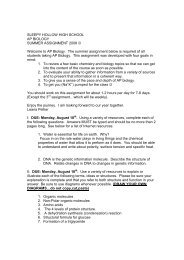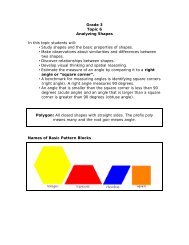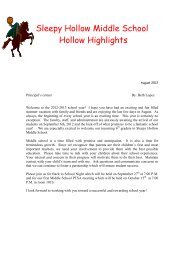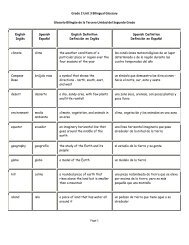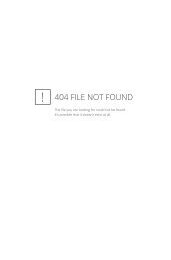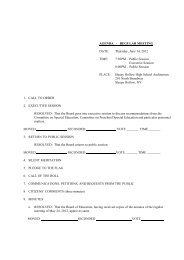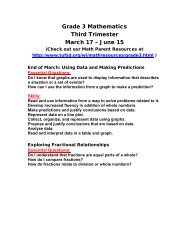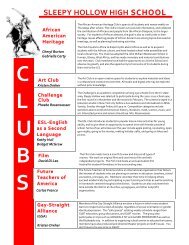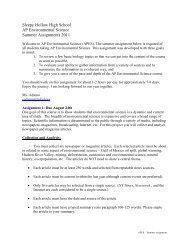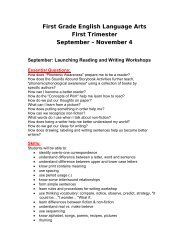Kindergarten English Language Arts Second Trimester November 5 ...
Kindergarten English Language Arts Second Trimester November 5 ...
Kindergarten English Language Arts Second Trimester November 5 ...
Create successful ePaper yourself
Turn your PDF publications into a flip-book with our unique Google optimized e-Paper software.
<strong>Kindergarten</strong> <strong>English</strong> <strong>Language</strong> <strong>Arts</strong><br />
<strong>Second</strong> <strong>Trimester</strong><br />
<strong>November</strong> 5 – March 16<br />
<strong>November</strong>:<br />
Essential Questions:<br />
What letter sounds do I know?<br />
How does hearing the beginning sounds of words help me to match<br />
sounds to letters?<br />
What is the difference between a letter and a word?<br />
How will recognizing letters of the alphabet help me begin to read and<br />
write?<br />
How does drawing a detailed picture help me to tell a story?<br />
What is the difference between print and pictures?<br />
What can I learn from a picture?<br />
How does retelling a familiar story help me become a reader?<br />
Why is it important to be a good listener?<br />
How does thinking about texts in my world help me become a better<br />
writer?<br />
Skills:<br />
Students will:<br />
• sit up straight and tall<br />
• watch and listen to the one who is talking<br />
• use poetry, songs, chants, shared reading, read alouds, nursery rhymes,<br />
and big books<br />
• identify the same sounds in different spoken words ("What sound is the<br />
same in sit, sip and sun?")<br />
• explore the alphabet<br />
- practice lower-case letter formation<br />
- understand letters have a name, sound and picture that helps us<br />
remember the sound<br />
- short vowel sounds<br />
- begin to understand that letters represent sounds and together they<br />
become words<br />
• begin to isolate individual sounds within spoken words ("What is the first<br />
sound in cat?")<br />
• notice the similarities and differences among the letters<br />
• listen for and match pictures of words with the same beginning sounds<br />
• begin to demonstrate some letter-sound relationships<br />
• identify high-frequency words on word wall
• read own name and names of friends<br />
• capitalize names when writing<br />
• understand directionality of print<br />
• point while reading<br />
• choose topics from their world for their writing<br />
• begin to use sentences in their writing<br />
• begin to use conventions in writing (capital letter, period, question mark)<br />
• read their own writing<br />
• revise writing over time to ensure their picture/labels/words match their<br />
story<br />
December & January:<br />
Essential Questions:<br />
What strategies can we use to tackle difficult words?<br />
How will recognizing letters of the alphabet help me begin to read and<br />
write?<br />
How does recognizing familiar words sometimes help me to read<br />
predictable text?<br />
Do I write some letters or words to tell a story?<br />
Can I choose a topic to write a story about?<br />
Why is it important to be a good listener?<br />
How does hearing the beginning and ending sounds of words help me to<br />
match sounds to letters?<br />
Skills:<br />
Students will:<br />
• respond to directions/questions<br />
• react appropriately to what others say<br />
• use poetry, songs, chants, shared reading, read alouds, nursery<br />
rhymes, and big books<br />
• practice isolating individual sounds within spoken words ("What is<br />
the last sound in cat?")<br />
• begin to explore syllables<br />
• understand and utilize the letter-sound chart<br />
• listen for and match pictures of words with the same<br />
beginning/ending sounds<br />
• highlight high frequency words during shared reading<br />
• identify high frequency words on word wall<br />
• identify first and last letters in words<br />
• identify first and last words in sentences<br />
• develop an understanding of what authors and illustrators do
• draw representationally with details<br />
• label pictures with letters and words<br />
• use the word wall to write familiar words<br />
• write own first name and the names of some friends<br />
• choose topics from their world for their writing<br />
• use sentences in their writing<br />
• begin to space words when writing<br />
• practice using conventions in writing (capital letter, period, question<br />
mark)<br />
• read their own writing<br />
• revise writing over time to ensure their picture/labels/words match<br />
their story<br />
• practice upper-case letter formation<br />
• understand letters have a name, sound and picture that helps us<br />
remember the sound<br />
• begin to understand that letters represent sounds and together they<br />
become words<br />
February & March:<br />
Essential Questions:<br />
What can we do when we want to spell a new word in our writing?<br />
What do good readers do when they read?<br />
How do writers add on to their stories that are finished?<br />
How does recognizing more high frequency words help me to read<br />
predictable texts?<br />
How does using directionality, spaces, and punctuation help me to read<br />
my own writing?<br />
Why is it important to recognize the difference between fiction and<br />
nonfiction texts?<br />
Why is it important to be a good listener?<br />
How does hearing the beginning and ending sounds of words help me to<br />
match sounds to letters?<br />
How do personal experiences help me understand my world?<br />
Skills:<br />
Students will:<br />
• respond to directions/questions<br />
• react appropriately to what others say<br />
• take turns speaking in a group<br />
• make appropriate and/or asks relevant questions<br />
• sort objects/picture cards by beginning and ending sounds<br />
• rhyming words
• make predictions about stories<br />
• blend spoken phoneme to form words using tapping to<br />
represent each sound /b/ /i/ /g/<br />
• segment spoken words into component sounds to represent each<br />
sound ("How many sounds are there in /b/ /i/ /g/?")<br />
• utilize the letter-sound chart<br />
• practice recognizing and writing last name<br />
• highlight high frequency words during shared reading<br />
• continue adding high frequency words to word wall<br />
• read high frequency words with automaticity<br />
• locate uppercase and lowercase letters in print<br />
• practice using the kindergarten reading strategies<br />
• use developing knowledge of letter-sound correspondences to spell<br />
independently (invented spelling)<br />
• utilize directionality, spaces and periods<br />
• include uppercase and lowercase letters appropriately when writing<br />
• prepare for writing by visualizing, rehearsing orally, and sketching<br />
• write from their own real-life experiences<br />
• prepare for writing by thinking about sequence (first, then, next, last)<br />
• write about "small moments" by zooming in<br />
• sketch/label/write across pages (booklets)<br />
• revise writing to add details<br />
• revise sketches/labels/writing for accuracy and to add details



